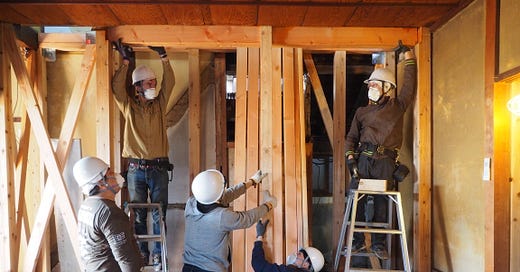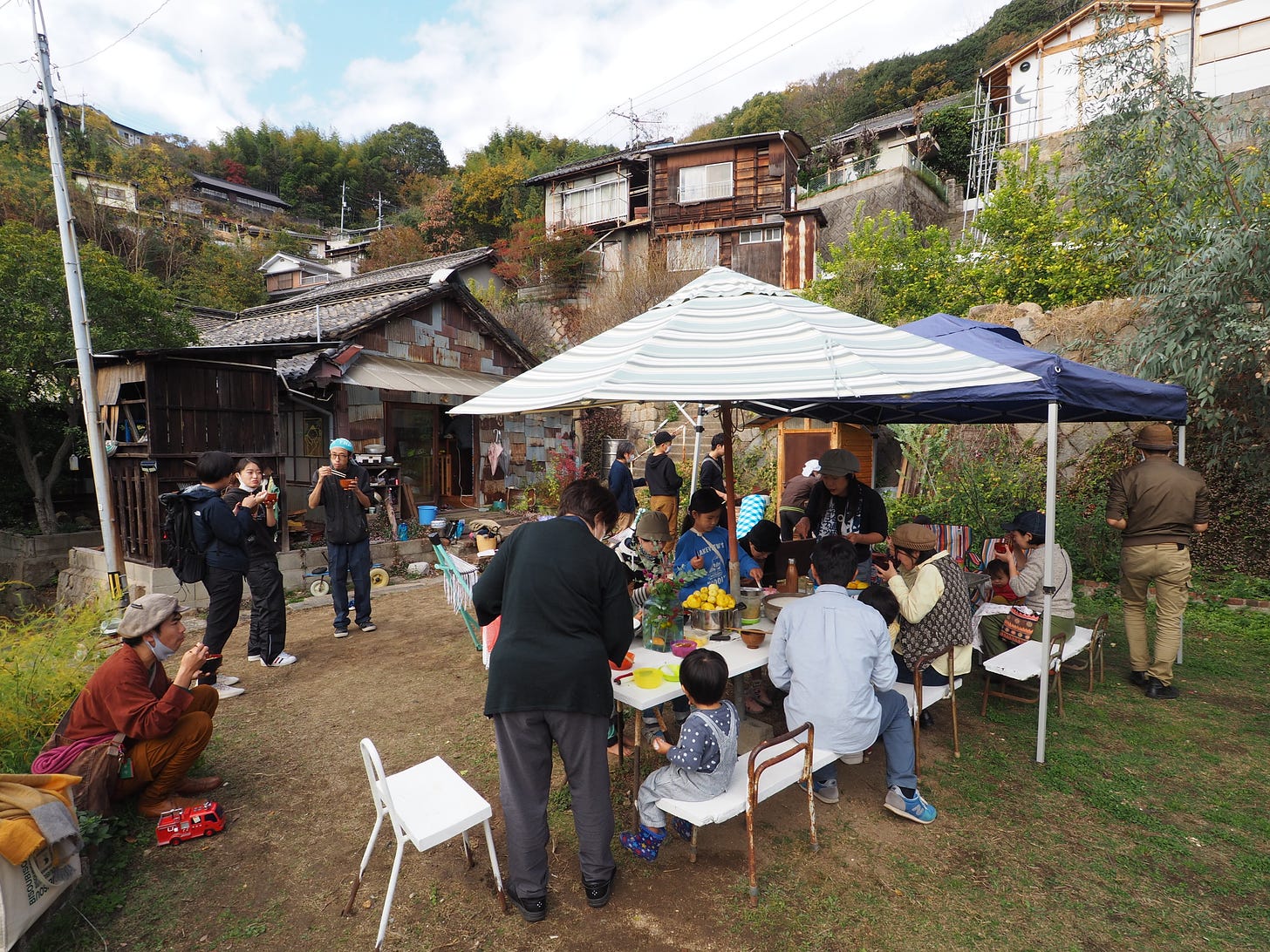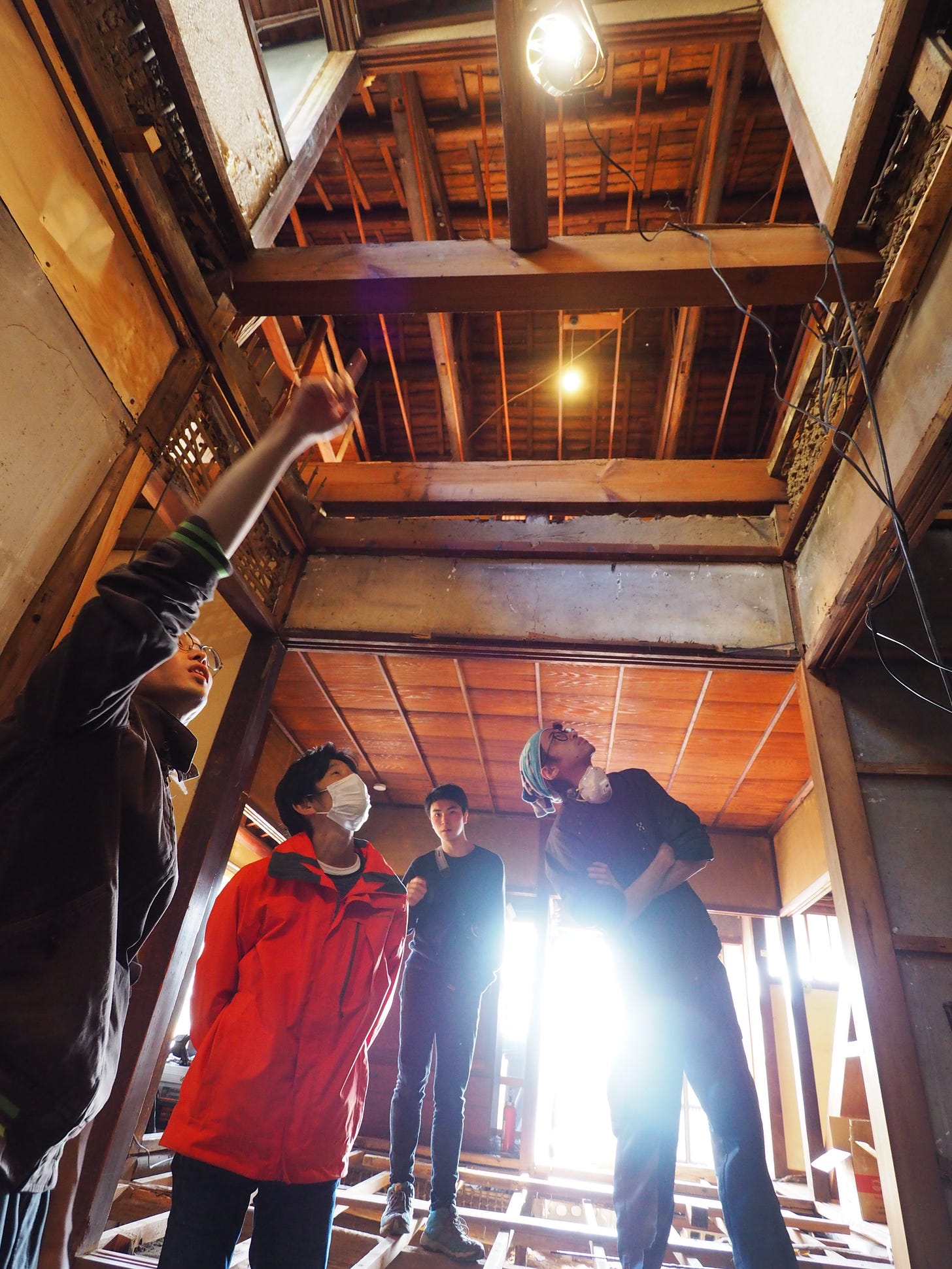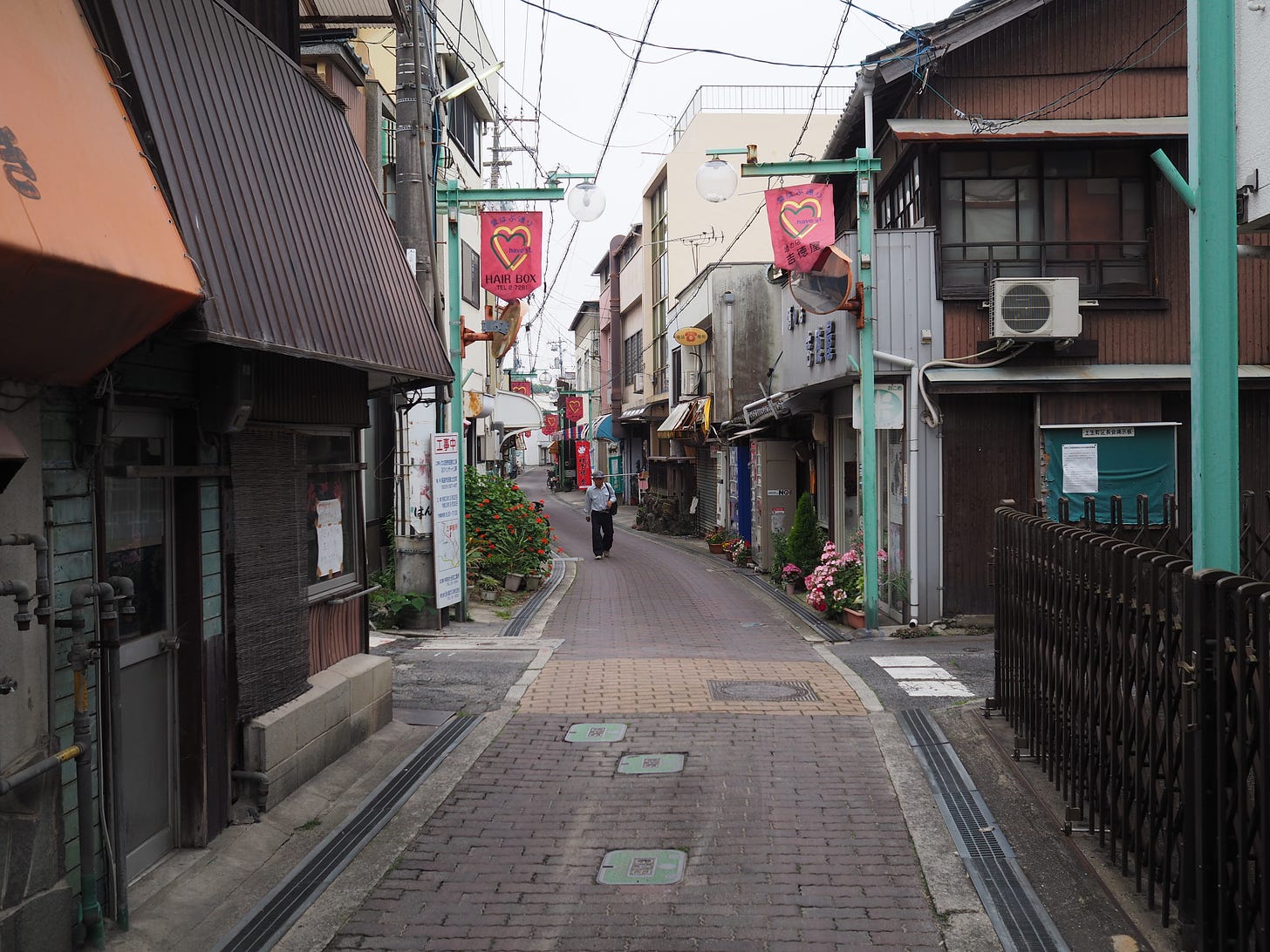I was down in Onomichi for the past week, building Labyrinth House for the sixth time in as many months. Our small group of friends is completely rebuilding and transforming a decaying 1930s-era hillside house into a semi-public space where people can come together for communal activities. The first floor will have a large tatami room with a stage for holding talk events and screenings, plus a kitchen that will be used to prepare food for big community meals. The second floor will have a large gallery, studio, and workshop space, along with private living space. On the back of the site is another house and warehouse that we hope to turn into a shop, guest room, and library. It’s a passion project, built by volunteers on a property that is being given to us for free. When I’m down in Onomichi, I become so immersed in the construction work and social interactions that it’s hard to type up anything more than daily notes. But I want to explain a bit of why I am so interested in akiya, or vacant houses.
Labyrinth House was vacant for around 15 years before my friend moved in a few years ago, and is one of hundreds of akiya in central Onomichi. Akiya are a ubiquitous feature of the post-growth landscape in urban and rural Japan. As the population declines, millions of buildings have become vacant in villages, small cities, and in the margins of metropolises like Tokyo, decaying both physically and as financial assets. I have been fascinated by akiya since I came to Tokyo in 2014 (I wrote my master’s thesis on the topic in 2017) because these spaces demonstrate how the logic of the market starts to implode in a post-growth society. Akiya have become seedbeds for social communities, artistic spaces, small businesses and alternative ways of life on the margins of the capitalist city.
Onomichi is perhaps the best place in Japan to see how a local culture of akiya renovation and reuse can take root and evolve. Despite its accessible location, stunning scenery, rich history, and popularity as a tourist destination, central Onomichi has an abundance of vacant houses, especially on the slopes above the shopping arcade that are only accessible by steep and narrow walking paths. Updated building codes that require vehicular access make it impossible to build new structures here. Because in the Japanese real estate market value is considered to reside in the land, not the buildings on top (a legacy of the growth era and a topic for another post), Labyrinth House and many of the other houses here no longer have any value at all as real estate. Since the late 2000s, the non-profit organization Onomichi Akiya Saisei Project (Aki-P) has facilitated their reuse through a vacant house bank, and a sizable community of local activists and migrants from other parts of Japan have fixed up an impressive number of buildings into homes, galleries, bakeries, cafes, shops, guest houses, studios, and community spaces. Many receive the deeds to their akiya for free.
If you want to find an interesting akiya in a shrinking community in Japan today, your best bet would not be a real estate office. Most places are never put “on the market.” Instead, you should take a walk and find places that catch your eye. You should start visiting frequently, build trust locally, talk to activists and people in the know, get introductions from neighbors. As the supply of vacant houses far outstrips demand on the margins of post-growth society, markets can no longer effectively set prices, but conversely, it becomes easier to tap into use values through non-market means. People may be unable or disinclined to sell their properties to the highest bidder, much less know how much something is worth, but owners are sometimes surprisingly open to handing over the deed or letting people use a space for free for purposes that serve the community. Then all you need is a relatively small sum of money mostly for materials, a network of people eager to build something together, and access to architectural knowledge and carpentry skills that were once shared and reproduced within local communities but have been specialized and professionalized in the modern economy, and you’re up and running as an akiya activist. Our community at Labyrinth House is not unlike a yui-gumi, when people in Japanese villages used to lend their labor to neighbors to re-thatch roofs, seed rice paddies, or accomplish other big tasks. Post-growth renovation culture thus comes full circle, rediscovering the multiple layers of human relationships that capitalism seeks to flatten into one-dimensional market transactions.
The fact that real estate exchange values across Japan are almost certain to decline in the years ahead might seem remarkable at a time when homes have become scarce and extraordinary expensive in the United States. Prices have also risen to all-time highs in certain parts of central Tokyo that are considered to be population decline-proof, but on the vast and porous post-growth periphery, akiya are becoming less like financial assets and more akin to natural resources, available to be harvested by those who wish put in the time and substantial effort to reclaim one from natural decay (just wait until you hear about the termite damage at Labyrinth House).
This all sounds great, replies the post-growth skeptic, but isn’t a renovation project like Labyrinth House just part of a cycle of gentrification? The urban decay and regeneration of the sort that sociologist Sharon Zukin identified in 1980s New York occurs in stages:
1) Local decline leads to rising vacancy and falling real estate exchange values
2) Artists, bohemians, and social outcasts appropriate spaces for alternative uses
3) An area becomes hip, increasing demand and displacing the original pioneers
4) Spaces are reintegrated into the dominant process of capital accumulation
Of course, this still happens in a post-growth economy. Before my friend Yu Ohtani moved to Labyrinth House, he spent most of a decade in Leipzig, where he was a researcher and activist involved in founding a community space in a marginal section of the city. Post-reunification Leipzig had experienced an epic population collapse, leaving the city strewn with vacant spaces that were occupied by squatters and activists in the 2000s and early 2010s. Then things began to change around 2015, when real estate prices and population growth went through the roof. Gentrification occurs not just within cities, but between them. Detroit becomes the new Brooklyn, Leipzig the new Berlin. Moreover, capital still finds many opportunities to turn depopulating places into profitable tourist destinations. A massive expansion of the inbound tourism industry was a key part of the strategy Japan had in mind to sustain its growth before covid blew everything up. Property prices and investment were going up again in many places for the first time in decades. Niseko, a once sleepy town in Hokkaido, saw its land prices spike thousands of percent as Aussies, Hongkongers and others have rushed to buy ski condos. Onomichi is also full of new businesses catering to the foreign tourists who used to come to cycle across the bridges to Shikoku—including some backed by serious capital such as a fancy hotel that opened a few months ago along a shuttered shopping street on an island south of town.
Very well. I do not intend to claim that a new economic system will supersede capitalism in post-growth society, but merely that the margins of the city become amenable to sustaining spaces that exist at least partly outside of, if always in tension with, the forces of the market. In his research in Leipzig, Yu identified three ways that the city deals with the problem of vacancy—by restoring abandoned spaces to the market, preserving them as historical or cultural heritage, or returning them to nature. But there are many spaces for which none of these prescriptions are viable—houses on the slope in Onomichi that would cost too much to renovate into profitable businesses, are not special enough to justify public preservation, and which cost too much to demolish (Labyrinth House would need to be demolished and removed entirely by hand—something that would cost several hundred thousand dollars!). So these places sit vacant and unused, until someone is motivated and clever enough to access the use value through non-market means.
Japan is now chock-full of disused spaces and things—no longer exchangeable, but still useable. One of the carpenters who came to work with us for a few days this week lives in a town on the coast of Wakayama, south of Osaka. He recently got a ship pilot’s license because someone offered to give him a sailing yacht. A couple of years ago, he began tying up scraps of wood from his construction projects and dropping them at a spot near the port where the local fishermen gather before sunrise and make bonfires. He built up a rapport with some of the old guys, and eventually one of them offered to give him a boat if he got a license. Next time, he plans to come to Onomichi by sea—about a day’s sailing on the smooth currents of the Inland Sea. There are tons of free boats available in Onomichi, too, the others say. Just like houses, owners are often eager to give them away to avoid the running costs of ownership. We should get one and share it so we can visit the islands nearby! We could find a seaside house, too, use it to link together a network of akiya!
Free houses! Free boats! The possibilities of life in capitalist ruins. What interests me is how the material conditions of post-growth society might lead to new forms of social relations. Out of the ruins of a capitalist economy based on private ownership, we could see the appearance of networks of sharing and collaboration across a post-growth commons. If assets no longer appreciate, there is less incentive to enclose and privatize them, and greater incentive to create networks that can help to defray the cost of tapping into latent use values. Think of all the unused spaces and things in a post-growth society as an enormous commons—the social resources and wealth accumulated under growth. Private ownership in perpetuity is an outmoded concept unsuited to an era of population decline. We should all feel a sense of ownership over the unused spaces in our communities. Reclaim the right to the post-growth city!
When seen in such a way, the post-growth city can sometimes feel liberating and ripe with possibility—indeed, more possibility than a growing city where capitalism strives to commodify and homogenize all aspects of urban space and everyday life. In the ruins, there are just buildings slowly decaying within nature, people with whom to forge connection, and a chatty grandpa down in the port who wants to give you a free boat. Labyrinth House is our homestead on the post-growth frontier—a place where security derives not from its financial value on a balance sheet, but the social value of the community it creates.
After seven days of construction, I’m typing this up on the Shinkansen as I speed through 800 kilometers of near continuous urbanization between Hiroshima and Tokyo. At night, the scenery outside the window blurs into an endless tapestry of points of light. My thoughts wander to the dark in between, where millions and millions of vacant spaces wait to be discovered and reanimated.
—
Much more to come on Labyrinth House and akiya in future posts. For now, you can follow our progress on Instagram. Before I hopped on the bullet train home, I stopped by a century-old public bath in the city of Kurashiki that is in danger of shutting down. The next day, I kicked off another big renovation project at a public bath in Tokyo—the topic of my next post.








I hadn't heard about this akiya phenomenon, but it reminded me of a guy I met in Houston 20+ years ago, who built art houses for single mothers out of discarded building materials.
https://texashighways.com/travel-news/roadside-oddities-the-legacy-of-dan-phillips-creator-of-huntsvilles-boot-house/
Also of this book.
https://www.npr.org/2017/04/27/523587179/in-walkaway-a-blueprint-for-a-new-weird-but-better-world
Very interesting post.
Hi Sam, Gianni speaking here. I'm new to Substack (I've just finished the About page for my newsletter, Tokyo Calling, but haven't published anything yet) and I was checking out who else was writing about Japan when I found you.
Two years ago I traveled around Japan (from my home in Yokohama to Hiroshima, roughly following the coast) and more than once, as you pointed out, I found akiya and shuttered shotengai everywhere, particularly in Toba, Mie Prefecture, and Imabari (Ehime). I even passed through Onomichi on my way to Hiroshima but didn't have enough time to stop.
Looking forward to reading more of your stories. In the meantime, I downloaded your Master's dissertation.